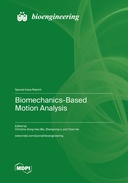Explore

Biomechanics-Based Motion Analysis
0 Ungluers have
Faved this Work
Login to Fave
Collectively, the studies presented in this reprint have used various validated biomechanical models or proposed novel methods of motion analysis to gain new insights into health-related problems and sports performance.
This book is included in DOAB.
Why read this book? Have your say.
You must be logged in to comment.
Rights Information
Are you the author or publisher of this work? If so, you can claim it as yours by registering as an Unglue.it rights holder.Downloads
This work has been downloaded 57 times via unglue.it ebook links.
- 57 - pdf (CC BY) at Unglue.it.
Keywords
- adolescent idiopathic scoliosis (AIS)
- anterior cruciate ligament deficiency
- anthropometric measurement
- Anthropometry
- base of support
- bi-LSTM
- biomechanical model
- Biomechanics
- biomedical informatics
- characteristic points
- classroom behavior
- co-simulation
- competitive swimming
- composite index
- coordinate measuring machines
- coupled
- deep learning
- Degeneration
- dental unit chair systems
- Dentistry
- durotaxis
- duty factor
- Electromyography
- embryo implantation
- EMG–force relation
- Extracellular matrix
- femoral neck fracture
- Finite element
- finite element analysis
- Finite element method
- freezing of gait
- Gait
- gait analysis
- gait initiation
- gait-phase prediction
- ground reaction force
- hand exoskeleton design
- healthy adults
- human ankle model
- human choriocarcinoma cell
- IDEEA
- in vivo study
- inertial measurement units
- Intelligent System
- Intention recognition
- internal fixation
- intervertebral disc
- intramedullary fixation
- joint moment
- joint power
- Kinematic alignment
- kinematics
- knee and hip
- ligament strain
- lower limb
- Machine learning
- marker-free video
- markerless motion capture system
- mechanical alignment
- medicine
- motion identification
- motion simulation
- multibody simulation
- multivariable linear regression
- muscle activation
- Muscle Fatigue
- muscle fiber conduction velocity (MFCV)
- muscle force computation
- musculoskeletal multibody dynamics
- n/a
- negative heel shoes
- normal walking
- normative data
- OpenSim
- optimal feature
- paraspinal muscle
- paraspinal muscle symmetry index (PMSI)
- parkinson’s disease
- Performance
- pose estimation
- position measurement
- positive heel shoes
- posture
- posture analysis
- Pregnant women
- product of exponentials formula
- proximal humerus fracture
- proximal junctional failure
- rasterstereographic back shape analysis
- ratio-based body measurement
- redundant feature
- Rehabilitation
- rehabilitation protocol
- rollback
- running economy
- running style
- Schroth exercise
- segmental centers of mass
- sensor
- shoulder activity
- spinal alignment
- spinal biomechanics
- spinal cord injury (SCI)
- spinal loading
- spinal reconstruction
- Spine
- Sports
- stiffness
- stride frequency
- surface electromyography (EMG)
- surface electromyography (sEMG)
- surface topography
- thema EDItEUR::M Medicine and Nursing
- thoracolumbar
- thoracolumbar spine
- Total knee arthroplasty
- two-dimensional (2D) image
- velocity fluctuations
- vertical oscillation
- walking speed
- walking speed classification
Links
DOI: 10.3390/books978-3-0365-8026-5Editions

